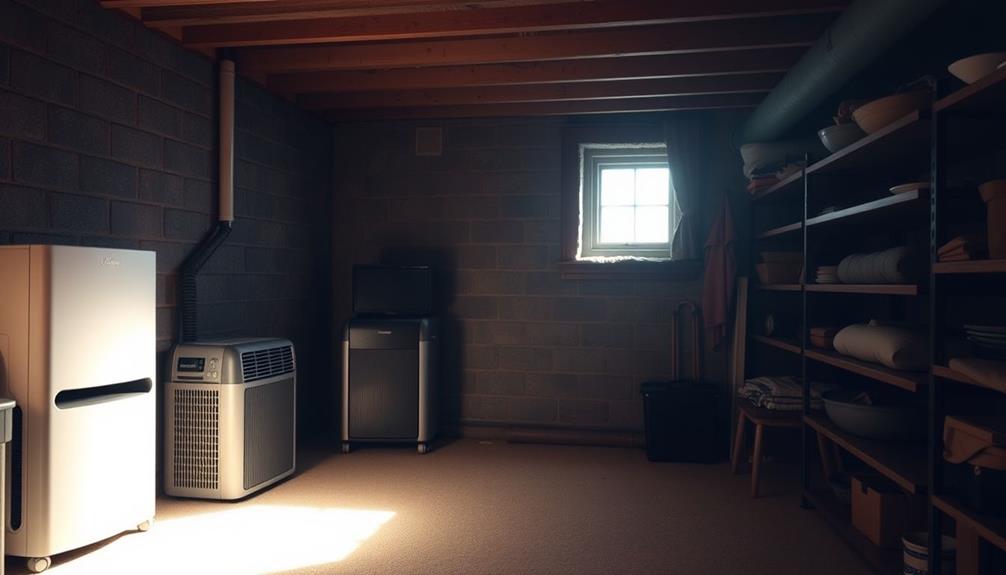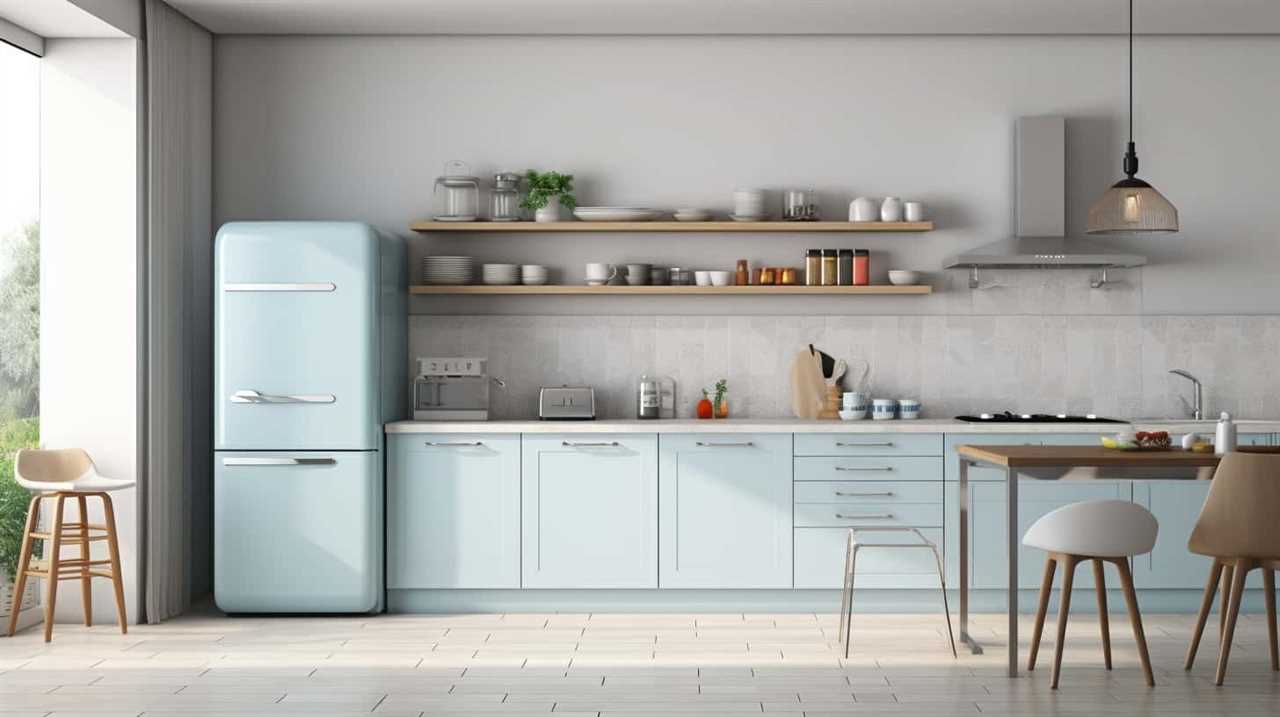When selecting the perfect dehumidifier for your basement, begin by assessing the levels of humidity present. It is advisable to aim for a range of 30-60% in order to prevent the growth of mold. It is also important to consider the type of dehumidifier you will need: refrigerant models are effective in damp conditions, while desiccant models are better suited for cooler spaces. Make sure to choose a unit with adequate capacity – a standard recommendation is 10 pints per 500 sq ft. Take into account factors such as drainage options, noise levels, and energy efficiency when making your decision; opting for Energy Star-rated models is a wise choice. Keeping up with regular maintenance is crucial for optimal performance. By bearing all of these considerations in mind, you can find a dehumidifier that meets your requirements perfectly. Explore additional tips to ensure you select the most suitable option!
Key Takeaways
- Assess your basement's size and humidity level to determine the appropriate dehumidifier capacity needed, typically 10-12 pints per 500 sq ft.
- Choose between refrigerant models for high humidity and desiccant models for cooler spaces based on your basement's environment.
- Consider energy efficiency by selecting Energy Star-rated units that consume 15% less energy, leading to long-term savings.
- Evaluate drainage options, opting for automatic systems to minimize manual emptying and maintenance efforts.
- Look for features like built-in humidistats to maintain ideal humidity levels and reduce mold growth.
Importance of Basement Dehumidifiers
A basement dehumidifier plays an essential role in maintaining a healthy home environment. By keeping humidity levels in check, you can prevent mold growth, which thrives in environments with relative humidity above 60%. Ideally, you want to maintain indoor humidity between 30-60%, as recommended by the EPA. This range not only improves air quality but also helps reduce allergens that can affect your health.
Additionally, maintaining low humidity levels can enhance your overall cleaning efforts, as high moisture can hinder the effectiveness of cleaning products and promote dirt accumulation Key Factors in Choosing a Home Cleaning Service.
Moreover, basement dehumidifiers protect your home's structural integrity by preventing moisture damage. Excess moisture can lead to wood rot and the deterioration of building materials, compromising your home's durability. By addressing these issues proactively, you safeguard your investment.
In addition to protecting your home, a dehumidifier can notably improve comfort in your living spaces above the basement. It eliminates musty odors and enhances overall indoor air quality, making your home a more pleasant place to be.
Plus, utilizing a dehumidifier can boost energy efficiency by reducing the load on your HVAC system, resulting in lower energy costs over time. Investing in a quality basement dehumidifier is a smart step toward a healthier, more comfortable home.
Types of Dehumidifiers

When it comes to choosing a dehumidifier for your basement, understanding the different types can make all the difference.
You'll find two main categories: refrigerant models and desiccant models. Refrigerant models use cooling coils to condense moisture from the air, making them effective for high humidity environments. On the other hand, desiccant models absorb moisture, which makes them ideal for cooler spaces.
For peak air quality, consider using an ozone air purifier alongside your dehumidifier to eliminate allergens and odors in your basement.
Portable dehumidifiers are popular for basement use due to their flexibility and ease of setup. If you're looking for a more integrated solution, whole-house systems work with your HVAC to manage humidity throughout your entire home.
Many dehumidifiers are Energy Star-rated, providing you options that remove anywhere from 30 to 70 pints of moisture daily, depending on your basement's humidity levels.
If you're dealing with particularly damp conditions, consider investing in industrial-strength portable dehumidifiers, which can handle over 70 pints of moisture removal each day.
Key Features to Evaluate

Selecting the right dehumidifier involves evaluating several key features that can greatly impact its performance and your comfort. When you're shopping for a model, keep these factors in mind:
1. Capacity: Choose a dehumidifier with a capacity of 10 pints for every 500 sq ft of your basement space. If conditions are very damp, consider increasing that to 12 pints for effective moisture removal.
Additionally, just as you'd choose appropriate tough dog names for a strong personality, verify the dehumidifier you select can handle the specific humidity challenges of your basement.
2. Drainage Options: Decide whether you prefer a manual drainage bucket that requires regular emptying or an automatic drainage system, like a gravity drain or condensate pump, for added convenience.
3. Energy Efficiency: Look for Energy Star-rated units, as they consume 15% less energy than standard models, which helps lower your electricity costs.
Additionally, consider the noise level of the model, especially if you use your basement for living or recreational purposes. A dehumidifier with a built-in humidistat can help maintain ideal humidity levels between 30-60%, preventing mold and enhancing your comfort.
Maintenance Best Practices

Keeping your dehumidifier running smoothly requires regular maintenance to prevent issues and guarantee peak performance. Start by cleaning or replacing filters every 1-3 months. This guarantees ideal airflow and efficiency.
It's also important to take into account the overall environmental impact of energy use in your home, as efficient appliances contribute to a more sustainable household, similar to the benefits of geothermal energy utilization.
Next, check and clean the condensate drain line monthly to avoid clogs that can lead to overflow and potential damage.
You should also inspect and clean the evaporator and condenser coils at least twice a year. This step is vital for maintaining efficient moisture removal and preventing humidity issues.
Monitoring humidity levels with a hygrometer is necessary, too. It allows you to adjust the dehumidifier settings as needed for ideal performance.
Don't forget to schedule professional maintenance annually. This proactive approach guarantees long-term reliability and helps address any potential issues before they escalate.
By following these maintenance best practices, you can keep your dehumidifier in top shape, effectively managing moisture and improving air quality in your basement.
Cost and Installation Factors

Understanding the costs and installation factors associated with dehumidifiers is essential for making an informed decision. You'll find that costs can vary greatly based on the type you choose. Additionally, consider the impact of proper ventilation and energy consumption when selecting a unit, as these can affect both efficiency and comfort levels in your basement.
Here's a quick breakdown:
- Portable units: These typically range from $150 to $300 and are often DIY-friendly, making installation a breeze.
- Whole-house systems: Expect to pay between $1,000 and $3,000, including installation fees. These often require professional help, especially if complex drainage options are involved.
- Maintenance costs: Don't forget to factor in regular upkeep, like filter cleaning and checking drainage systems for clogs.
Opting for Energy Star-rated models can lead to long-term savings, as they use about 15% less energy.
Additionally, if you choose a unit with continuous drainage options, you'll minimize maintenance hassles since these need less manual emptying.
While the upfront investment might seem steep, considering the importance of HVAC maintenance and the associated energy savings can make a considerable difference in the overall cost of ownership.
Make sure to assess all these factors before making your final choice!
Additional Humidity Reduction Methods

When it comes to reducing humidity in your basement, there are several effective methods you can implement alongside a dehumidifier. These additional humidity reduction methods not only help reduce excess moisture but also improve humidity control throughout your home.
| Method | Purpose | Benefits |
|---|---|---|
| Extend Downspouts | Direct rainwater away from the foundation | Reduces basement moisture levels |
| Clean Gutters and Downspouts | Prevents clogs and overflow | Keeps humidity levels stable |
| Adjust Landscaping Irrigation | Prevents overwatering | Minimizes moisture in surrounding soil |
| Use Vent Fans | Expels humidity from kitchens/bathrooms | Decreases overall moisture levels |
Frequently Asked Questions
How to Pick a Dehumidifier for a Basement?
To pick a dehumidifier for your basement, measure the space size, assess humidity levels, consider drainage options, and choose energy-efficient models. Don't forget to check noise levels for comfort in your living area.
Is It Better to Undersize or Oversize a Dehumidifier?
It's better not to undersize or oversize a dehumidifier. Oversizing causes short cycling, while undersizing leads to inadequate moisture control. You should select a unit that matches your basement's size and humidity levels for peak performance.
What Size Dehumidifier Do I Need for a 1200 Sq Ft Basement?
For a 1,200 sq ft basement, you'd need a dehumidifier with a capacity of 40 to 70 pints per day. Assess humidity levels and consider a larger unit if moisture issues are major.
What Do You Look for When Buying a Dehumidifier?
When buying a dehumidifier, you'll want to evaluate its capacity for your space, energy efficiency, noise level, drainage options, and features like humidistats or air filters. These factors guarantee peak performance and comfort.
Conclusion
Choosing the right dehumidifier for your basement is like finding the perfect umbrella for a rainy day. Just as an umbrella shields you from getting soaked, a good dehumidifier protects your home from moisture damage. Remember to take into account the type, features, and maintenance to keep your basement dry and healthy. With the right choice, you'll create a safe haven below ground, just like that trusty umbrella that keeps you dry while you navigate through life's storms.










